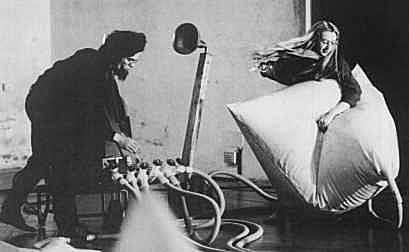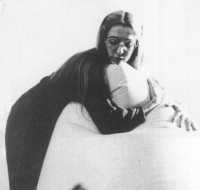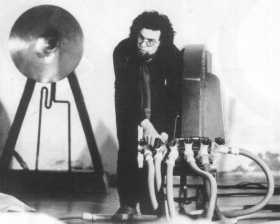

Pneumaphone Project
Godfried-Willem Raes
1977-1983
Myths & Mythology
Pneumaphone Catalogue
Pneumaphone Performances
Technical information for Organisers
Pictures of recent performances
Boreas, Favonius, Kolpia, Zu, Awhio-whio, Ehecatl, Apu-Hau, Oonawieh Unggi, Gucumatz, Aeolus, Tawhiri, Teshub, Seth, K, Eurus, Notus, Astraeos, Adad, Apu-Matangi, Ventus, Tembo, Xix, Shu, Njord...
all pneumaphones, pneumatic soundsculptures or instruments, or both, if you wish. Flutes, single-reeds, lipps, tongues, double-reeds, sirens, whistles, membranes, mirlitons, water-organs, cavity-resonators and such, make up the individual voice of each single pneumaphone, all together a wind orchestra: Pneumaphone.

Music is air in motion, but not all moving air makes a sound just because it is moving. Air is life, because life needs breath. Whenever we hear music, we breath vibrating air. Without air there can be no music, because sound only exists where the air vibrates. Pneumaphone is airsound. Pneumaphone is windsound. Pneumaphone makes air move, compresses the air in many lungs. Pneumaphone is mechanised breath and converts wind into vibration. The vibration of the air is made to depend on the movements of the air. How the air moves depends on all the lungs: Pneumaphone has twenty. These twenty lungs are inflated cushions. You are invited to sit, roll, bounce or lie down on the cushions to make the air move.
The sounds produced depend on the movements of these lungs, on the movements of the people joining the pneumaphone, on the people being seduced by it. Pneumaphone integrates sound and movementintrinsically. Movement becomes tactile and sensual; a roll of bodies in a bath of vibrating air; a living musical environment, an invitation to active participation, to move through.

Pneumaphone was built according to a design and concept by the Flemish music-maker Godfried-Willem Raes. Its realization involved the entire Ghent-based Logosteam and took a few years of research and labour.
The project was realized technicallywith the support and help of Moniek Darge, Tom Flamant and Guy De Bievre. A first version and try-out took place as a result of a commission for the German city of Essen, on the occasion of their annual "Klang und Spielstrasse".
Since then, the project - in an ever-growing format - has been presented at the Eindhoven 'Apollohouse', the Bonn 'Beethovenhalle', the Brussels 'Atelier', the Ghent Royal Conservatory, at Neerpelt, the Stuttgart 'Kulturkilometer', the Ferarra 'Aterforum-festival', in Meise, at 'De Singel' in Antwerp ...

After all, Pneumaphone is quite large a project and as occasions to present it to the general audience are - for material reasons- rather limited, we thought it to be a good idea to document it on a record. This record has now become a collector's item; if you are lucky you might still get a copy at Logos
The Pneumaphone project can be presented to audiences in three different ways : firstly, as an installation piece for audience participation - a kind of acoustic or musical playground if you like; a second way of presenting the project is in the format of a concert for Pneumaphones alone; or, lastly, as a concerto for organ and Pneumaphone
Pneumaphones: Myths & Mythology
Each pneumaphone was given the name of a mythological wind-deity, belonging to an ancient far-away cultural tradition. Moniek Darge, who did the research, describes them below for you, whilst the photographers Samuel Desplenter (+), Giovanni Deschampheleire and Marco Caselli offer you their pictures.
|
mythology is anonymous collective art
|
Pneumaphone Catalogue
The compressors
VENTUS, or "the wind"
In antique mythology, Ventus, The Wind, was held to be a fertilizing agent. Hence the low pressure compressor of the pneumaphone project is called Ventus, fertilizing wind.
SHU
is the Egyptian wind. He lifts his daughter, Nut - the sky - all over the earth. Shu used to be the principle of life in Heliopolitan cosmology, as he created the world by separating the earth from the sky. Shu, in terms of Pneumaphone compressors, is the most powerful of them all. For the Pneumaphones he is thus the principle of life.
SET
Set is a younger wind of Egyptian origin. Being a son of Nut, the sky, he claimed the kingdom for himself alone and since he felt that he had been badly treated he offended Ra with storms and thunder. As a form of punishment, Set was forced to secure a steady breeze to guarantee the forward motion of Osiris' boat. In another version of the myth, Set is banned to the nightly firmament, where he is left free to make as much noise as it pleases him as a god of wind and storms. Set is said to have red hair and red eyes, since red, in ancient Egypt was the colour associated with everything bad. Set thus became the prototype for the fourth and youngest large compressor in this company.
ASTRAEUS
The Greek Dawn and Dusk Wind is one of numerous lovers of Eos, Goddess of Dawn. The stars merge with the dawn in the east and Astraeus rises. The union of Eos and Astraeus first gave birth to the Morning Star, then left it alone in the sky. All the stars were then born from Eos and every wind, except Astraeus, The Dawn and Dusk Wind himself. The high pressure turbo-compressor is Astraeus, since he produces most of the air for the pneumaphone project.
MEI
The child of Set... It blows the Foehn through the Alps and makes people irresponsible at times.
The Pneumaphone sculptures
ADAD, is the Babylonian god of Storm and Thunder. In the Babylonian myth of the Flood, Adad is described vividly. Utnapishtim is instructed by Ea, who was the first of the Babylonian order of Gods, to build a ship into which he would bring "the seed of all living things". "(Whatever I had) I laded upon here: Whatever I (had) of gold I laded upon here Whatever I had of silver I laded upon here Whatever I had of all the living beings I laded upon here..." Then Adad, the God of Storm and Thunder, thunders. The Gods themselves are alarmed and cower like dogs against the wall of heaven. Adad, the Storm, rages for six days and six nights. Adad is the pneumaphone with a large drum because Adad storms and thunders violently. |
AEOLUS, (Aiolos), "The Earth Destroyer". Son of Poseidon and Greek god of Winds. He rules his rebellious subjects - the Winds - imprisoned in a cave on the Eolian islands, or carried around in a leather bag. As soon as he disobeys Zeus by allowing his subjects to escape without permission, they cause shipwrecks and destruction. Once upon a time, Aeolus asked Odysseus to bring the leather bag of Winds back to the Greek continent, but the Winds escaped and Odysseus was once again shipwrecked. Aeolus, the God of Winds, is the pneumaphone with four plastic flutes, symbolizing the 4 wind directions under his control. |
APU-HAU is one of the eleven children of Tawhiri, the God of Hurricanes and Storms in Polynesian myth. These children are the eleven Storm Gods. Apu-Hau means "Fierce Squalls". Thus, the pneumaphone Apu-Hau can produce harsh cries by sudden and vehement gusts of wind through his prepared metal organpipe. |
APU-MATANGI is another of the eleven Storm God children of Tawhiri. Apu-Matangi means "Whirlwind" in Polynesian myth. And therefore the pneumaphone Apu-Matangi changes the rhythms and timbres of his sounds with a pneumatic rotator. |
AWHIO-WHIO is the Australian God of whirlwinds. His aboriginal name Awhio-Whio is onomatopoeic; it imitates the sound of the Australian whirlwinds. The pneumaphone Awhio-Whio also imitates the sound of his name with two plastic flutes amplified by two small, metal cone-shaped horns. |
BOREAS is the Greek NORTH WIND, or "the devouring". He is cold and hard. Boreas blows from Thrace (Northern Greece), where he lives in a mountain cave. Once, he abducted the daughter of Erechtheus, King of Athens, and forced her to marry him. She became the cool breeze bringing fresh air in summertime. The Athenians worshipped Boreas, because he played an important role in their Persian Wars. It is also Boreas who raised the storm which drove Herakles off his course to the island of Cos. The Early Pelasgians (neolithic people immigrating to Greece) sprang from Boreas' teeth... As the Greek North Wind is cold and hard, and because he is symbolized by an old, bearded, winged man, the pneumaphone Boreas makes deep growling sounds and has a stiff severe shape. His sounding pipes are filled with water, enabling the particular sound flexibility of his voice. |
EHECATL, the Aztec Wind God, supports the heavens with his hands and is associated with vegetation and fertility> Hence he was sometimes shown as a bearer of grain and maize cobs. Temples dedicated to Ehecatl were circular in shape because, like the wind, he was not restricted to any one direction. Ehecatl, the Lord of the Winds, was one of the many aspects of Quetzalcoatl and symbolized as a conch shell cut in cross-section. This shell was worn by priests as a "Wind Jewel". Ehecatl, Lord of the Winds, wears a "wind mask" that projects like a pointed snout covering the lower part of his face. The mask is painted bright red and is derived from the snout of the Mexican Whistling Toad (Rhinophryne dorsalis). This shape suggested the Earth Mother, a cross between an alligator and a toad. Small pottery idols of Ehecatl's wind mask were kept by Aztecs in their homes. Ehecatl is the pneumaphone with a red circular horn projecting like a snout. Thus the pneumaphone Ehecatl suggests his circular temple and his red wind mask, which mimics the sound of a whisling toad. |
EURUS (euros), is one of the wind-sons of Eos and Astraeus. Eurus is the Southeast and East Wind. Eurus stands for hurricane and so he is the loudest and most violent pneumaphone. He is quite unreliable, but on the other hand also capable of the softest tones of all the Pneumaphones. His acoustic mechanism is based on a cavity resonator, an extremely sensitive sound generator creating colored bands of noise. |
FAVONIUS, is the Latin name of the Greek Zephyros, "the Wind of the West", announcing spring in the midst of February. He is symbolized as a winged young fellow. Once the symbolic, jealous Favonius blew Apollo's discus in the wrong direction on purpose, thus killing his rival Hyacintus. The pneumaphone Favonius is a living contradiction between its soft whistle sounds and its quite ferocious shape.The black tubes can be seen as fangs or tusks; the air moving in these ribbed plastic electrical tubes causes the sounds. The mechanism is based on cavity resonance and is highly pressure-sensitive as far as pitch is concerned. |
GUCUMATZ is the Wind of the Nine Caverns in the Mixtec Indian Creation Legend. Gucumatz manifested as a winged serpent and his mate, the Wind of the Nine Serpents, manifested as a bird. Both caused the waters of the Deluge to subside and land appeared. The pneumaphone Gucumatz has 9 plastic sounding tubes because he is the Wind of the Nine Caverns. The idea of the final pneumaphone project evolved from the construction of Gucumatz, and therefore, Gucumatz caused land to appear. |
|
K, is the Mayan Wind God. He is thought to be a form of Chac Mool, the Rain and Thunder God. Owing to the destruction of nearly the entire literature of the Mayas, the myths of the Mayas have largely passed into oblivion. K is the mysterious tall and slender pneumaphone, concealing his soundmechanism as a never to be known secret. His shape can be associated with his name. |
KOLPIA, is the Wind of the Phoenician Creation Legend. In the beginning there was Air and Chaos, from which proceeded Wind and Desire. This Wind was Kolpia. Wind and Desire produced Mot, God of Death, in the shape of an egg. In this, creatures were formed which remained motionless and dormant until the egg opened, wherefrom the sun, the moon, and the stars were projected. The harsh sounds of a brass reed and the archaic shape of the exponential horn are at the origin of this pneumaphone's name Kolpia. |
NJORD, the Wind, Rain and Storm God of the Nordic myth was a giant. He is a masculine form of Jord, the Earth Mother Goddess. In the list of Zodiacal houses his residence is given as Noatun, which comes under the sign of Libra. It seems that when Njord displaced Jord, it was considered inappropriate to allot him her mansion and her sign of the Zodiac, therefore he was given the next one in sequence. Njord is the tallest pneumaphone, a giant. He transforms the wind in waterbubble-sounds, since he is the Rain and Storm God. |
NOTUS, (Notos), another son of Astraeus, brings warm winds from the SOUTH. As the Latin word "Notus" means also "known", the name of this warm wind is given to the pneumaphone with the known warm sound of a wooden flue organpipe. The organ pipe used here was taken from an authentic 17th century organ and a whole was sawn in his body. Notus has a leather bellow, rising with increasing pressure, and thus closing the whole and lowering the pitch of the sound. Notus calms you down, he brings deep rest and peace. |
OONAWIEH UNGGI, "The Oldest Wind", is a Wind God of the Cherokee Indians. Oonawieh Unggi was one of their main deities, together with the bisexual thundergod "The Red Man or The Red Woman" and the Hunting God "Slanting Eyes", who dwelt in the Blue Ridge Mountains of Virginia. The pneumaphone Oonawieh Unggi, the Oldest Wind, although small, expresses dignity by his elegant shape and severe sound. |
TAWHIRI, God of hurricanes and Storms, had thirteen children. In Polynesian myth, eleven of these children were Storm Gods. Their names may have been a record of storms and conditions encountered on the long sea voyages of the Polynesians in colonizing the Pacific. The pneumaphone Tawhiri amplifies his sirenlike sounds by a big parabolic soundreflector since he is the Lord of Hurricanes. As a matter of fact, for his mechanism five small copper sirens were made. |
|
TEMBO, is the most recent of the pneumaphones and the last one at the same time. This is also why he is not playing on this record, as he was not yet made at the moment these performances took place. As an African windgod, he must be black and thus he seems to disappear on the black vinyl of the record. He was built in 1994 at the occasion of the presentation on the pneumaphone project at the Antwerp 'Singel'. |
TESHUB, is the Hurrian Hittite ruler over storms, holding lightning in his hand. He drives a primitive kind of chariot drawn by bulls over the heads of personified mountains. The bull is his sacred animal.Teshub was the slayer of the dragon Illuyankas.When Teshub displaced his father Kumarbi as king of the Gods, Kumarbi organised a conspiracy against his son Teshub. He planned to create a mighty rebel who could defeat Teshub and destroy his city Kummiya. He enlisted the support of the Sea in his plan and married the Sea's daughter. Also, "Great Mountain Peak" was his mate. In due course a son was born to him and was named Ullikummi or "Destroyer of Kummiya, the city of Teshub." The body of this child was made of diorite stone. The son was carried down to earth and placed on the shoulders of Upelluri, (an Atlas figure), where he grew apace in the midst of the sea. When he had grown so big that the sea reached only up to the middle of his body, the Sun-God espied him and was filled with anger and dismay. He hastened to inform Teshub and the latter climbed to the top of a high mountain, whence he could see the monstrous Ullikummi rising out of the sea. Teshub wept bitterly and decided to go to battle. With the ancient saw, which heaven and earth was divided by, the diorite-stone was severed and the power destroyed. The large pneumaphone made of heavy wooden timbers and a large hyperbolic metal soundreflector is Teshub. He produces fierce, rather lowpitched squeaks produced by two mutually exclusive prepared large brass reeds. |
XIX, alias number nineteen, is the contemporary Pneumaphone god with the mysterious voice. His sound is Japanese in character and as a Zen-boudhist, he always tends to forget his own name. XIX rules over the Japanese Sea and hence his wind causes waves within both of his oildrums, thus controlling and modulating his whistling melodies originating from his four horns. These symbolise the four directions of winds. His sound inflections are subtle and Japanese. His favorite colour is red and his appearance, elegant and serene. |
ZU, is the Assyrian Storm God symbolized in the form of a bird. Zu once stole the tablets of Creation and took them to a mountain top where he hid them. The Sun-God secured their return with the aid of a net in which Zu was ensnared. The pneumaphone Zu is small and inconspicious, but his character is sly, since he produces unexpected sliding reed sounds. His horn is silvered and his neck was shaped after some waterbird. |
Moniek Darge
september 1983 - august 1987
"Concerto for Pneumaphones and Organ"
Both the classic pipe organ and our pneumaphones are musical instruments capable of converting a steady stream of air from their lungs in vibrating air and thus in sound. But, whilst in the organ, pressure is kept as much stable and constant as technically possible, in the Pneumaphones pressure varies all the time.The pitch and stop-changes of the organ are made a perfect complement to the new sounds from the Pneumaphones. At times they contrast, at other times they harmoniously integrate. Although both instruments share a common principle, in this piece they are balanced against each other, hence the title, concerto... From a compositional point of view, the piece is really a sound-colour composition. Pitch relations and instructions are only prescribed in the score in relation to each other. The piece is a conditional interactive composition, as far as pitch is concerned. Although the piece is not really a music-theatre composition, the concert performance which we are presenting here, has ample material for the eyes. The bizarre and grotesque shapes of the eighteen Pneumaphones playing here, contrast highly with the severe and baroque exterior look of the hieratic organ. The picture on the cover illustrates this in part. Whilst the Pneumaphone performers are moving, turning and tossing all the time on their inflatable cushions - performing the score by changing the air-pressure delivered to the pneumatic sculptures - the organist remains so to speak moveless behind his keyboard and desk. A confrontation between the sensual and almost erotic play on the pneumaphones and the rather pious organ, incapable of suppressing any association to the atmosphere of churches. But, Pneumaphone has a distinct ritual meaning of its own, a meaning that is clearly revealed in such a performance. The relation between both instruments is one of concertant interaction. The dominating presence of a past -a gold decorated baroque organ front- versus a playfull and despite everything more accesible, contemporary sculptural instrument, based on a similar technology: pneumatics and acoustics.
Performers for the recording, made at the occasion of a new-music festival that took place at the Ghent Royal Conservatory on february 6th 1986 were:
- Pneumaphones: Guy De Bievre, Moniek Darge, Tom Flamant, Inge Kerkhove, Wim Belaen, Rik Deschynck, Hans Vuylsteke
- Organ soloist: Johan Huys
- Pneumaphone valve-controller and conductor: Godfried-Willem Raes
- Concertproducer: Muzikon & Logos Foundation
- Recording: Logos-studio, Jef Pringiers
- Cover picture: Giovanni De Schampheleire
"Pneumaphone Performance"
From june 8th to 15th of 1986 strange sounds emerged from the tenth century Chiesa di San Romano, situated at the base of the cathedral in the Italian town Ferrara. The Ferranese people did have a hard time in suppressing their curiosity until the moment of the official opening of the Aterforum-Festival. Of course, Logos was'nt innocent in these. This roman church only decorated by its immanent sobriety, housed the complete Pneumaphone-project. The large compressors, three in a row, took the place of the altar. The windgods were all over the place. The inflatables waiting for the people to join. Many thousands of of people did come and lended their intrigued ears to the discovery and examination of the sounds. Within the shortest possible time after the opening, the former church was stuffed with a hoity- toity,a rolling spaghetti of people trying to make the windgods speak their voice. Next to the Pneumaphone-project, presented here as an installation, an acoustical playground in a way, the Logos-ensemble also presented a concert-performance, the recording of which we are presenting here. After a short and ritual vocal introduction, and the tutti caused by the global inflation of all cushions, Notus and Boreas - the Greek Southern and Northern winds - are responsible for the bassline in the score, whilst the rain and stormgod Njord speaks his bubbling watersounds. These melt together in an amalgam with the flutelike sounds of the Roman, Polynesian and Maya winds. Eurus, the son of Eos and Astraeos introduces a conflict in the harmony of this amalgam, reminding us his past as a hurricane. A vivid single combat follows with the Japanese XIX, playing melodic patterns through his bulletcartridges filled with oil . Xix wins the duel, but his victory is received by the other windgods with wild staccato's from all directions. Even Oonawieh Unggi, the oldest wind from the Cherokee indians, participates. The staccato reaction is terminated by the whirlwind Apu-Matangi, starting at the same time the last section of the piece. Soft tones from fluepipes play a soft polyphonic texture, until Adad, the Babylonian thundergod, raises his voice. The serene walls echo, in the nightly hours of the performance, the final chord. Applause.
Performers during this concert were :
- Pneumaphones: Katie Couck, Moniek Darge, Tom Flamant, Godfried-Willem Raes
- Concertproducer : Aterforum Festival Ferrara
- Recording : Enrico Trevisani
- Photographer : Marco Caselli
Some previous and upcoming performances:
- 16-18.09 2022: New York, Lincoln Centre for Performing Arts (USA)
- 14-15.05.2022: Rennes (France)
- 17-18.11.2019: Tallinn (Estland)
- 11-12.10.2019: Lissabon, Portugal Fundacao centro cultural de Belem
- 07.2019: Ghent Feasts, Ghent, Baudelopark.
- 06-07.04.2019: Dublin, Ireland , The Ark
- 16-19.02.2019: Ottawa, Canada
- 09-11.11.2018: Bijloke muziekcentrum, 50 jaar Logos
- 24.06.2018: Alba Nova Festival, Alden Biesen
- 11.06.2017: Potsdam, Fahrradkonzerte, Sans Souci Festival, Germany
- 04-05.05.2017: Stavanger, Big Bang, Norway.
- 10-11.02.2017: Enschede, Nederland
- 13.11.2016: Opera, Gent
- 06-07.11.2016: Bozar, Bruxelles
- 01.11.2016 : De Singel, Anrwerpen , Big Bang
- 11-12.07.2009 : Manchester, International Festival (UK) The great Indoors.
- 13-14.06.2008 : Opera de Lille (France) , Oorsmeerfestival
- 09.03.2008 : CC Leuven, Wagehuys - Pepernoot music festival
- 02-03.03.2008 : CC Dilbeek - Pepernoot music festival
- 24.02.2008 : Cultural Center Diest
- 03.02.2008 : Cultural Center Strombeek Bever
- 01.11.2001 : Vooruit, Gent (Nemo project)
- 10.1994: De Singel, Antwerpen
- 06.1986: Ferrara, Aterforum Festival (Italy)
- 01.1986: Ghent, Royal Conservatory of Music
- 05.1984: Ghent, Museum of Modern Art (now SMAK)
- 1982: Bruxelles, Atelier Rue St.Anne
- 09.1981: Klang und Spielstrasse, Essen (BRD)
| Back to Logos Projects | Back to logos' main index page | To homepage Godfried-Willem Raes | To homepage Moniek Darge |
Last update:2022-09-20
